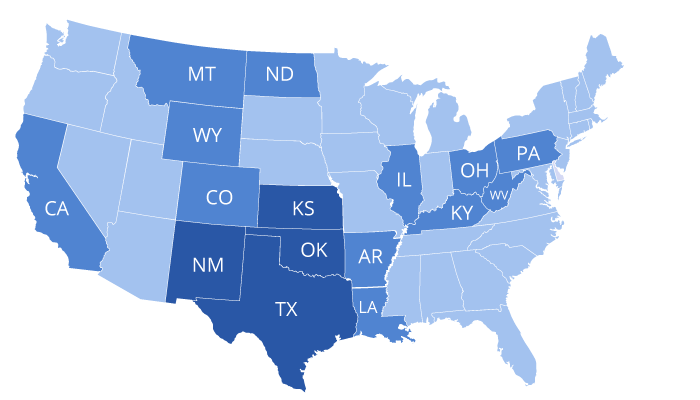Are Your Mineral Rights in a Good Area?
Locate your mineral rights and determine if they are in an active drilling area.
Sell Your Mineral Rights (Request an Offer):
One of the First
Step-by-Step Directions
It’s actually quite easy to see if your mineral rights are in an active dilling area. This video goes through the process step-by-step and each step is broken down in detail below the video.
Have problems? Contact us and we can usually determine if your minerals are in an active area pretty quickly. We look this up all the time for mineral owners.
Location is everything
Are Your Minerals in a Shale Play?
Perhaps you’ve just inherited mineral rights. Or maybe a landman came knocking and offered to lease your minerals and drill a well. In either case, you might be curious about where your minerals are located and if they are in a hot area.
The fracking boom quickly turned the United States into a leading oil and gas producer, granting us energy independence. Older oil fields and conventional drilling were replaced by fracked horizontal wells, often stretching 2-3 miles across multiple tracts of land. Overnight, oil fields that everyone thought were depleted were suddenly capable of producing enormous oil and gas quantities.
So, how do you know if your mineral rights are located in a desirable area?


Source: Texas RRC GIS interactive map
Find your property on a map
Step 1: Locate Your Mineral Rights
The first step is to locate your mineral rights on a map. Each state’s oil and gas regulatory agency has an interactive GIS viewer where you can put in the legal description of your minerals.
Need help using the GIS? We have a video that walks you through the process of locating your minerals on a map. We use Texas as an example, but most GIS viewers work similarly.
Once you find your mineral rights on the map, zoom out so that you can see where your minerals are in relation to the entire county.
Take a screenshot – we’ll use this later.
Compare your location with oil and gas activity
Easy 3-Step Process to Create Oil and Gas Overlay Maps
Locate Your Mineral Rights
Armed with your legal description and your states oil and gas regulatory commission’s GIS viewer, you can easily locate the tract of land in which you own interest. You’ll take a screen shot and save it for later.
Locate the Drilling Activity in Your County
Use ShaleXP to find a map of the drilling activity in your county. Take note of the ranking and upward (or downward) production trends. Then take a screen shot and save for later.
Overlay the Maps
Using Microsoft PowerPoint, overlay one map over the other, and change the opacity of the top map to make it transparent enough to see both maps. This will show you if your minerals are in an active area.

Source: ShaleXP Pecos County Map
Find local oil and gas wells
Step 2: Use a Heatmap
ShaleXP is a fantastic resource, and you don’t need a subscription to see a basic map of your county’s drilling activity.
Follow these steps:
- Navigate to State Directory
- Scroll down and select your county
- Take a screen-shot of your county’s drilling activity
While you’re on ShaleXP, it may be interesting to explore your state and county’s production graphs and notice the upward or downward trend as well as the state and national ranking.
Compare your location
Step 3: Overlay the Maps
Now that you have a screenshot of where your minerals are located within the county lines and a screenshot of the drilling activity within the county, we’ll overlay the maps so that you can see if your minerals are in an active drilling area.
- Open Microsoft PowerPoint
- Create a blank slide
- Drag and drop both screenshots onto the slide (drag the ShaleXP screenshot first)
- Right-click on the GIS screenshot and choose Format Picture from the menu
- Under Picture, select Transparency and reduce the transparency until you can see the ShaleXP map below the GIS map.
- Resize the images so that the county lines are the same size and you can see where your minerals are and the drilling activity.
Now, you should be able to see where your minerals are and if they are located in an active drilling area.
Even in Reeves County, Texas, which is the most productive county in the United States, there are good and bad areas to have mineral rights.
Location is probably the number one factor in determining the value of your mineral rights.
Source: Texas RRC GIS interactive map

Valuation 101
How We Value Mineral Rights
There are many factors that play into the value of mineral rights. These include location, producing vs. non-producing properties, current oil and gas prices, well production figures, lease terms, and even the operator of the well or wells. We also look at the risks of buying and owning minerals that you are interested in selling.
Location
Minerals in the hottest shale plays are more valuable than those in older fields with conventional wells.
Producing vs. Non-Producing
Producing minerals are often worth more than non-producing minerals because they are generating revenue.
Oil & Gas Prices
When oil and gas prices drop, revenue drops, and sometimes operators are unable to continue operating the well.
Production
Highly productive wells (and off-set wells) can increase the value of your minerals.
Lease Terms
Favorable lease terms (such as a 25% royalty reservation) positively impact the value of the leased minerals.
Operator
A small number of operators are unethical, and their reputation automatically devalues your minerals.
Nationally Focused
Where We Buy Mineral Rights
We buy both producing and non-producing minerals in all oil and gas states. However, we are especially interested in Texas and Kansas mineral rights.
|
We even buy minerals in more obscure states, which produce very little oil and gas compared to other states.

Why Sell?
Why People Sell Their Mineral Rights
I am putting my affairs in order. I don’t want to burden my kids with the hassle of transferring ownership and managing small mineral rights. When my sister passed away, my niece and nephew had to hire an attorney to help them with the minerals. I don’t want my kids to go through that.
I inherited my mineral rights so they were sentimental, but I don’t really want to bother with managing them and filing extra tax returns. I decided to sell and use the money as a down payment on my house.
I had no idea how fast the oil production would decline. My checks are only 20% of what they were a few years ago. I should have sold my mineral rights when the wells were brand new and still generating huge royalties.
My oil wells have been producing for decades and the reserves are almost depleted. Once the wells are plugged, the value will be significantly lower. I’d rather cash out now.
I inherited mineral rights, but don’t want to be involved with fracking and fossil fuels. I would prefer to support renewable energy and do my part to reverse climate change.
